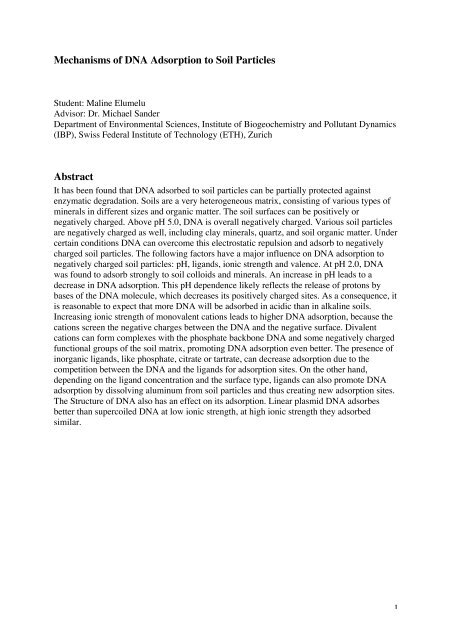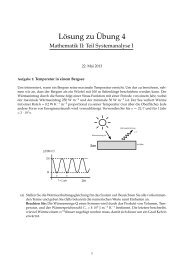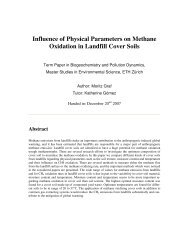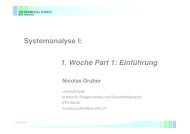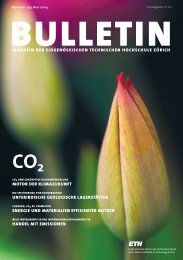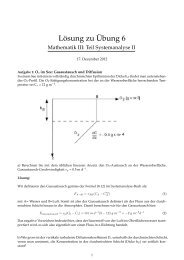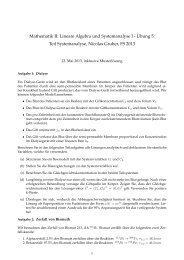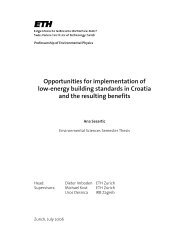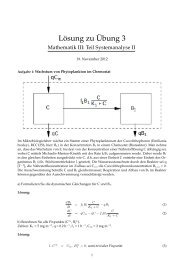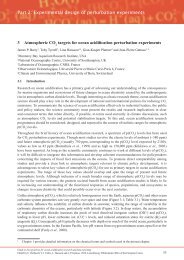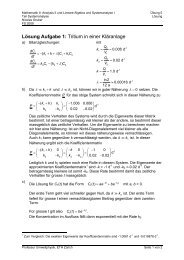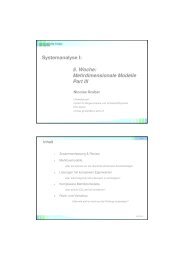Mechanisms of DNA Adsorption to Soil Particles Abstract - ETH - UP ...
Mechanisms of DNA Adsorption to Soil Particles Abstract - ETH - UP ...
Mechanisms of DNA Adsorption to Soil Particles Abstract - ETH - UP ...
You also want an ePaper? Increase the reach of your titles
YUMPU automatically turns print PDFs into web optimized ePapers that Google loves.
<strong>Mechanisms</strong> <strong>of</strong> <strong>DNA</strong> <strong>Adsorption</strong> <strong>to</strong> <strong>Soil</strong> <strong>Particles</strong><br />
Student: Maline Elumelu<br />
Advisor: Dr. Michael Sander<br />
Department <strong>of</strong> Environmental Sciences, Institute <strong>of</strong> Biogeochemistry and Pollutant Dynamics<br />
(IBP), Swiss Federal Institute <strong>of</strong> Technology (<strong>ETH</strong>), Zurich<br />
<strong>Abstract</strong><br />
It has been found that <strong>DNA</strong> adsorbed <strong>to</strong> soil particles can be partially protected against<br />
enzymatic degradation. <strong>Soil</strong>s are a very heterogeneous matrix, consisting <strong>of</strong> various types <strong>of</strong><br />
minerals in different sizes and organic matter. The soil surfaces can be positively or<br />
negatively charged. Above pH 5.0, <strong>DNA</strong> is overall negatively charged. Various soil particles<br />
are negatively charged as well, including clay minerals, quartz, and soil organic matter. Under<br />
certain conditions <strong>DNA</strong> can overcome this electrostatic repulsion and adsorb <strong>to</strong> negatively<br />
charged soil particles. The following fac<strong>to</strong>rs have a major influence on <strong>DNA</strong> adsorption <strong>to</strong><br />
negatively charged soil particles: pH, ligands, ionic strength and valence. At pH 2.0, <strong>DNA</strong><br />
was found <strong>to</strong> adsorb strongly <strong>to</strong> soil colloids and minerals. An increase in pH leads <strong>to</strong> a<br />
decrease in <strong>DNA</strong> adsorption. This pH dependence likely reflects the release <strong>of</strong> pro<strong>to</strong>ns by<br />
bases <strong>of</strong> the <strong>DNA</strong> molecule, which decreases its positively charged sites. As a consequence, it<br />
is reasonable <strong>to</strong> expect that more <strong>DNA</strong> will be adsorbed in acidic than in alkaline soils.<br />
Increasing ionic strength <strong>of</strong> monovalent cations leads <strong>to</strong> higher <strong>DNA</strong> adsorption, because the<br />
cations screen the negative charges between the <strong>DNA</strong> and the negative surface. Divalent<br />
cations can form complexes with the phosphate backbone <strong>DNA</strong> and some negatively charged<br />
functional groups <strong>of</strong> the soil matrix, promoting <strong>DNA</strong> adsorption even better. The presence <strong>of</strong><br />
inorganic ligands, like phosphate, citrate or tartrate, can decrease adsorption due <strong>to</strong> the<br />
competition between the <strong>DNA</strong> and the ligands for adsorption sites. On the other hand,<br />
depending on the ligand concentration and the surface type, ligands can also promote <strong>DNA</strong><br />
adsorption by dissolving aluminum from soil particles and thus creating new adsorption sites.<br />
The Structure <strong>of</strong> <strong>DNA</strong> also has an effect on its adsorption. Linear plasmid <strong>DNA</strong> adsorbes<br />
better than supercoiled <strong>DNA</strong> at low ionic strength, at high ionic strength they adsorbed<br />
similar.<br />
1
1 Introduction<br />
Many people are concerned about the evolutionary impact <strong>of</strong> genetically modified plants and<br />
microorganisms released <strong>to</strong> the environment. The release could lead <strong>to</strong> an unwanted spread <strong>of</strong><br />
these transgenes and tracer genes, which encode resistance <strong>to</strong> antibiotics, <strong>to</strong> native organisms.<br />
However, <strong>DNA</strong> adsorption in soils must have occurred long before the development <strong>of</strong><br />
genetically modified organisms and may have been <strong>of</strong> fundamental importance for microbial<br />
evolution and ecology.<br />
Lateral gene transfer among bacteria can occur through three different mechanisms:<br />
conjugation, transduction and transformation (13). During conjugation, plasmid <strong>DNA</strong> is<br />
directly transferred from a donor <strong>to</strong> a recipient cell. Transduction is a gene exchange mediated<br />
by bacteriophages. The uptake <strong>of</strong> naked <strong>DNA</strong> by competent bacterial cells is referred <strong>to</strong> as<br />
transformation (13). In the latter process, linear and supercoiled <strong>DNA</strong>, both either<br />
chromosomal or plasmid, can be acquired by the cell (12). Linear <strong>DNA</strong> is incorporated by<br />
substituting homologous sequences <strong>of</strong> the recipient’s genome. Contrarily, during plasmid<br />
transformation, a new plasmid replica is established in the recipient cell, where the plasmid<br />
can be replicated au<strong>to</strong>nomously (14). In soil environments <strong>DNA</strong> molecules are both released<br />
by dying cells and excreted actively by living cells (5). It has been found that <strong>DNA</strong> adsorbed<br />
<strong>to</strong> soil particles can be partially protected against enzymatic degradation (1,9).<br />
It is crucial <strong>to</strong> thoroughly understand the fate <strong>of</strong> <strong>DNA</strong> molecules in order <strong>to</strong> assess whether<br />
transformation can naturally occur, and, if so, its likelihood.<br />
The scope <strong>of</strong> this term paper is <strong>to</strong> provide a survey <strong>of</strong> possible interactions between <strong>DNA</strong> and<br />
soil particle surfaces, and <strong>to</strong> point out important fac<strong>to</strong>rs that affect <strong>DNA</strong>-surface interactions.<br />
First the structure <strong>of</strong> the <strong>DNA</strong> molecule and the chemical properties <strong>of</strong> some main<br />
constituents <strong>of</strong> soils will be discussed briefly. <strong>DNA</strong> is negatively charged below pH 5, so<br />
adsorption <strong>to</strong> positively charged surfaces such as aluminum and iron oxides is very likely.<br />
However, various soil particles are negatively charged, including clay minerals, quartz, and<br />
soil organic matter. To which extent and by what mechanism <strong>DNA</strong> would adsorb <strong>to</strong> these<br />
negative surfaces, depends strongly on the solution chemistry <strong>of</strong> the soil. In particular the<br />
following fac<strong>to</strong>rs are important and will be addressed: pH, ligands, ionic strength and valence.<br />
A pH below 5 generally promotes <strong>DNA</strong> adsorption by adding pro<strong>to</strong>ns <strong>to</strong> the bases <strong>of</strong> the<br />
<strong>DNA</strong>, creating positive sites in the molecule. High ionic strength <strong>of</strong> monovalent cations also<br />
promotes <strong>DNA</strong> adsorption, due <strong>to</strong> charge screening <strong>of</strong> negatively charged sites within the<br />
molecule and between the molecule and the surface. Divalent cations, especially calcium,<br />
have even a higher promotive effect. Calcium can form “inner-sphere” complexes with the<br />
phosphate groups <strong>of</strong> the <strong>DNA</strong> and form bridges between <strong>DNA</strong> and soil mineral surfaces. The<br />
mechanism <strong>of</strong> <strong>DNA</strong> adsorption is expected <strong>to</strong> strongly influence the desorption behavior and,<br />
therefore, the availability <strong>of</strong> adsorbed <strong>DNA</strong> for microbial transformation.<br />
2
2 General description <strong>of</strong> chemical properties<br />
2. 1 Chemical Properties <strong>of</strong> <strong>DNA</strong> and Sites <strong>of</strong> Interaction with <strong>Soil</strong> <strong>Particles</strong><br />
The <strong>DNA</strong> molecule consists <strong>of</strong> the<br />
bases guanine, cy<strong>to</strong>sine, adenine<br />
and thymine linked <strong>to</strong> pen<strong>to</strong>se<br />
sugars, which are connected <strong>to</strong><br />
each other by phosphate. The two<br />
strands <strong>of</strong> the molecule are hold<br />
<strong>to</strong>gether by H-bonds between<br />
complementary base pairs (Figure<br />
1). The pK a value for the<br />
dissociation <strong>of</strong> H 3 PO 4 <strong>to</strong> H 2 PO 4<br />
-<br />
is<br />
2.12 (17). Hence, above pH 2, the<br />
phosphate groups are likely <strong>to</strong> be<br />
negatively charged. The isoelectric<br />
point <strong>of</strong> <strong>DNA</strong> is about 5.0, below<br />
pH 5.0 the bases can accept<br />
pro<strong>to</strong>ns which creates positive<br />
charged sites in the <strong>DNA</strong> molecule<br />
(14). If the pH is above 5.0, <strong>DNA</strong><br />
is overall negatively charged (6). It<br />
can be considered as a polyanion<br />
(14).<br />
<strong>DNA</strong> forms a double helix which<br />
Figure 1: Structure formula <strong>of</strong> <strong>DNA</strong> (15). can form several conformations (9).<br />
Bacterial <strong>DNA</strong> can be arranged as a linear or circular molecule. The covalently closed circular<br />
form <strong>of</strong> bacterial plasmid <strong>DNA</strong> will spontaneously con<strong>to</strong>rt around its own axis, adopting<br />
twisted shape that is referred <strong>to</strong> as supercoiled.<br />
<strong>DNA</strong> could, in principle, adsorb <strong>to</strong> soil particles at various sites. The bases, the phosphate<br />
groups, and free hydroxyl groups <strong>of</strong> ribose at the end <strong>of</strong> each <strong>DNA</strong> strand are possible<br />
candidates for an interaction with soils.<br />
3
2.2 Surface Properties <strong>of</strong> <strong>Soil</strong> <strong>Particles</strong><br />
<strong>Soil</strong>s are a very heterogeneous matrix, consisting <strong>of</strong> various types <strong>of</strong> minerals in different<br />
sizes and living or death organic matter. This heterogeneity creates a vast multitude <strong>of</strong><br />
surfaces <strong>to</strong> which <strong>DNA</strong> can adsorb. These surfaces can be positively or negatively charged.<br />
Iron and aluminum oxides are positively charged at acidic <strong>to</strong> circumneutral pH and negatively<br />
charged at alkaline pH, so their charge is variable (16). Silicon oxides and the planar surfaces<br />
<strong>of</strong> clay minerals typically carry a net negative charge above slightly acidic pH.<br />
As both <strong>DNA</strong> and soil mineral surfaces, except for Al- and Fe-oxides, are negatively charged,<br />
<strong>DNA</strong> approaching a surface has <strong>to</strong> overcome electrostatic repulsion.<br />
Quartz, SiO 2 , the most abundant silica in rocks and soils has a point <strong>of</strong> zero charge near pH<br />
3.0 (2). Goethite is very abundant iron oxide in soils <strong>of</strong> temperate climate all over the world.<br />
The PZC <strong>of</strong> goethite is around pH 8.<br />
Isomorphic substitution in clay minerals leads <strong>to</strong> a permanent negative surface charge (2). At<br />
the edges <strong>of</strong> clay minerals, aluminum hydroxide functional groups are exposed <strong>to</strong> the<br />
environment. These hydroxyl groups can be pro<strong>to</strong>nated <strong>to</strong> carry a positive charge. Kaolinite, a<br />
1:1 sheet silicate with not much isomorphic substitution, has a point <strong>of</strong> zero charge at pH 3.6<br />
(16). More isomorphic substitution and therefore higher negative surface charges are found in<br />
the 2:1 phyllosilicates illite and montmorillonite. Montmorillonite has a point <strong>of</strong> zero charge<br />
<strong>of</strong> 2.5.<br />
4
3 Characteristics <strong>of</strong> <strong>DNA</strong> <strong>Adsorption</strong> <strong>to</strong> <strong>Soil</strong><br />
3.1 <strong>DNA</strong> <strong>Adsorption</strong> <strong>to</strong> Various <strong>Soil</strong> <strong>Particles</strong><br />
<strong>DNA</strong> adsorption <strong>to</strong> various types <strong>of</strong> soil particles with different surface properties has been<br />
studied. The main types <strong>of</strong> soil particles under consideration in this work are different sizes <strong>of</strong><br />
clay particles <strong>of</strong> a clay loamy Brown <strong>Soil</strong> (Alfisol), quartz (2), the iron oxide goethite, and the<br />
clay minerals kaolinite, illite, and montmorillonite (6,8). The chemical properties <strong>of</strong> the clay<br />
particles, goethite, the clay minerals kaolinite and montmorillonite are listed in Table 1. By<br />
H 2 O 2 -treatement <strong>of</strong> clay particles substantial parts <strong>of</strong> organic matter is removed from their<br />
surface, they will further be referred <strong>to</strong> as inorganic clays.<br />
Table 1: selected properties <strong>of</strong> soil colloids and minerals studied. a Data and figure legend<br />
taken from (6) (….) and (8)(….).<br />
soil colloid or mineral O.M. SESA PZC CEC composition<br />
(g kg -1 ) (m 2 g -1 )<br />
(cmol kg -1 )<br />
Total Clay (
A Langmuir isotherm for the adsorption <strong>of</strong> <strong>DNA</strong> <strong>to</strong> various soil colloid fractions and minerals<br />
has been found by Cai et al. (Figure 2). The properties <strong>of</strong> the soil particles are listed in Table<br />
1. The soil particles were inoculated with salmon sperm <strong>DNA</strong>. <strong>Adsorption</strong> was calculated<br />
indirectly by depletion <strong>of</strong> <strong>DNA</strong> from solution.<br />
Figure 2: Equilibrium adsorption <strong>of</strong> <strong>DNA</strong> from salmon sperm <strong>DNA</strong> (25-350 µg) on 10 mg <strong>of</strong><br />
soil colloids and kaolinite and 1 mg <strong>of</strong> montmorillonite. Inorganic clays have been H 2 O 2 -<br />
treated <strong>to</strong> remove organic matter from their surface. Figure and figure legend taken from 8.<br />
The adsorption maxima derived from Langmuir fits decreased with the following order:<br />
montmorillonite, fine inorganic clay, fine organic clay, kaolinite, coarse inorganic clay, coarse<br />
organic clay.<br />
Fine clays adsorbed 4-7 times more <strong>DNA</strong> than coarse clays per mg (Figure 2). However, note<br />
that the mass <strong>of</strong> adsorbed <strong>DNA</strong> is normalized <strong>to</strong> the mass rather than the surface area <strong>of</strong><br />
sorbent (see Figure 2). This point will be discussed further in the outlook section.<br />
The difference between inorganic clays and organic clays in the amount <strong>of</strong> adsorbed <strong>DNA</strong><br />
was not as big as between fine and coarse clays. However inorganic clays could adsorb more<br />
nucleic acid than organic clays. This larger adsorption in inorganic clays as been attributed <strong>to</strong><br />
surfaces <strong>of</strong> Fe-Al oxides, which were exposed after the organic material has been removed by<br />
H 2 O 2 (7).<br />
In inorganic clays and kaolinite, <strong>DNA</strong> is thought <strong>to</strong> adsorb mainly on the clay edges by ligand<br />
exchange. Aluminum hydroxides and hydroxyl-aluminum-clay complexes can adsorb organic<br />
ligands by this mechanism (7). It has been suggested that the hydroxyl groups <strong>of</strong> the ribose<br />
and the phosphate groups at the two ends <strong>of</strong> the <strong>DNA</strong> molecule are involved in ligand<br />
exchange. During ligand exchange strong bonds are formed. Therefore, <strong>DNA</strong> adsorbed with<br />
higher affinity <strong>to</strong> inorganic clays and kaolinite than <strong>to</strong> organic clays and montmorillonite.<br />
Because the coarse clay fraction comprised more kaolinite and the fine clay fraction in this<br />
study, the adsorption affinity was higher for coarse clays than for fine clays.<br />
Cai et al. (8) suggest that <strong>DNA</strong> adsorption <strong>to</strong> organic clays and montmorillonite occurs on the<br />
planar surface (<strong>of</strong> clays) by electrostatic interactions and that these interactions allow weak<br />
bonds and lead <strong>to</strong> a lower adsorption affinity. However, this explanation seems questionable<br />
in light <strong>of</strong> the fact that both <strong>DNA</strong> and surfaces are negatively charged. This point will be<br />
further discussed in the outlook section.<br />
According <strong>to</strong> Cai et al. (7) the strong bonds formed during ligand exchange made <strong>DNA</strong><br />
adsorption <strong>to</strong> inorganic clays exothermic. For coarse inorganic clay it was even more<br />
exothermic than for fine inorganic clays. That the adsorption <strong>to</strong> organic clays was<br />
6
endothermic, was explained by higher electrostatic repulsion between <strong>DNA</strong> and organic clays<br />
(7). <strong>Adsorption</strong> enthalpies <strong>of</strong> <strong>DNA</strong> were measured by a TAM air isothermal calorimeter.<br />
3.2 Influence <strong>of</strong> Solution Chemistry on <strong>DNA</strong> <strong>Adsorption</strong><br />
3.2.1 pH Dependent <strong>Adsorption</strong><br />
Figure 3: Equilibrium adsorption <strong>of</strong> 200 µg <strong>of</strong> salmon sperm <strong>DNA</strong> on 10 mg <strong>of</strong> soil colloids<br />
and minerals in the range <strong>of</strong> pH from 2.0 <strong>to</strong> 9.0. Figure and figure legend taken from (8).<br />
At pH 2.0, all <strong>of</strong> the added <strong>DNA</strong> was found <strong>to</strong> adsorb <strong>to</strong> soil colloids and minerals. Increasing<br />
pH from 2.0 <strong>to</strong> 5.0 resulted in a dramatic adsorption decrease from 20 <strong>to</strong> 0.51-2.98 µg mg -1<br />
for organic clays and montmorillonite and from 20 <strong>to</strong> 5.26-6.98 µg mg -1 for inorganic clays<br />
and kaolinite (8). This pH dependence likely reflects the release <strong>of</strong> pro<strong>to</strong>ns by bases <strong>of</strong> the<br />
<strong>DNA</strong> molecule, which decreases its positive charge. A further increase in pH from 5.0 <strong>to</strong> 9.0,<br />
still leads <strong>to</strong> less <strong>DNA</strong> adsorbed, but the decrease is not as steep. As a consequence, it is<br />
reasonable <strong>to</strong> expect that more <strong>DNA</strong> is adsorbed in acidic than in alkaline soils.<br />
With high salt concentrations, in the presence <strong>of</strong> divalent cations, the pH dependent<br />
adsorption behavior <strong>of</strong> <strong>DNA</strong> changes dramatically. Lorenz et al. (10) found that in presence<br />
<strong>of</strong> magnesium adsorption <strong>to</strong> sea sand was highest under alkaline conditions due <strong>to</strong> cation<br />
bridging.<br />
7
3.2.2 Influence <strong>of</strong> Ligands on <strong>DNA</strong> <strong>Adsorption</strong><br />
In soil environments, especially in the rhizosphere, various organic and inorganic ligands are<br />
present. It is important <strong>to</strong> know how these ligands affect <strong>DNA</strong> adsorption in order <strong>to</strong> make<br />
statements about the fate <strong>of</strong> <strong>DNA</strong> in soils.<br />
Cai et al. (6) investigated the adsorption <strong>of</strong> salmon sperm <strong>DNA</strong> <strong>to</strong> soil particles in the<br />
presence <strong>of</strong> phosphate and the inorganic acids citrate and tartrate. Citrate and tartrate can<br />
occur in the rhizosphere in concentrations up <strong>to</strong> 10-20mM, the concentration <strong>of</strong> phosphate can<br />
be even higher, especially in fertilized agricultural land.<br />
Figure 4: <strong>Adsorption</strong> <strong>of</strong> <strong>DNA</strong> on soil<br />
colloids and minerals in the presence <strong>of</strong><br />
increasing concentration <strong>of</strong> organic acids<br />
and phosphate. Figure and figure legend<br />
taken from 6.<br />
Geothite, organic and inorganic clay as<br />
sorbents: For goethite, as well as<br />
inorganic and organic clays, adsorption<br />
decreased with increasing citrate, tartrate<br />
and phosphate concentrations. This<br />
inhibition <strong>of</strong> adsorption by ligands was<br />
attributed <strong>to</strong> competition between the<br />
<strong>DNA</strong> and the ligands for adsorption sites.<br />
Furthermore increasing ligand<br />
concentrations increased the negative<br />
charge on the surface and hence increased<br />
the electrostatic repulsion between <strong>DNA</strong><br />
and soil colloids. Phosphate was found <strong>to</strong><br />
have the highest ability <strong>to</strong> decrease <strong>DNA</strong><br />
adsorption on<strong>to</strong> goethite and soil colloids,<br />
followed by citrate and tartrate. Adding<br />
<strong>DNA</strong> <strong>to</strong> the system before adding the<br />
ligands, led <strong>to</strong> higher adsorption, than<br />
simultaneous addition. Lowest adsorption<br />
was observed, when the ligand was added<br />
first followed by <strong>DNA</strong>.<br />
Montmorillonite and kaolinite as<br />
sorbents: The amount <strong>of</strong> <strong>DNA</strong> adsorbed<br />
<strong>to</strong> montmorillonite and kaolinite<br />
decreased with increasing ligand<br />
concentration in the range <strong>of</strong> 0-5mM.<br />
<strong>DNA</strong> adsorption was then enhanced again<br />
with increasing concentrations <strong>of</strong> tartrate<br />
and citrate from 5 <strong>to</strong> 80 mM and<br />
increasing phosphate concentration from<br />
5 <strong>to</strong> 200 mM. The authors speculated that at high ligand concentrations, the ligands could<br />
promote <strong>DNA</strong> adsorption <strong>to</strong> montmorillonite and kaolinite by dissolving aluminum from<br />
8
kaolinite and thus creating new adsorption sites. The formation <strong>of</strong> aluminum-phosphate<br />
precipitates and bridging <strong>of</strong> soluble Al 3+ between the negatively charged mineral surfaces and<br />
the phosphate backbone was further suggested as explanation for an enhanced adsorption<br />
process. In the cases in which the ligand was added first, adsorption was higher than in cases<br />
in which <strong>DNA</strong> and ligand simultaneously or <strong>DNA</strong> first (6).<br />
3.2.3 Influence <strong>of</strong> Salts on <strong>DNA</strong> <strong>Adsorption</strong>: Ionic Strength and Valence<br />
A quartz crystal microbalance with dissipation was used by Nguyen et al. (2) <strong>to</strong> measure<br />
adsorption rates <strong>of</strong> supercoiled plasmid <strong>DNA</strong> <strong>to</strong> a quartz surface (Figure 5). The attachment<br />
efficiency α is the ratio <strong>of</strong> the measured adsorption rate under different experimental<br />
conditions <strong>to</strong> the diffusion-controlled (i.e. maximum) adsorption rate <strong>of</strong> negatively charged<br />
<strong>DNA</strong> <strong>to</strong> a positively charged surface. At pH 6 and pH 8 the plasmid <strong>DNA</strong> and the silica<br />
surface are both negatively charged. It is therefore likely that solution chemistry has a strong<br />
effect on the electrostatic repulsion, which has <strong>to</strong> be overcome for a successful adsorption.<br />
Figure 5: <strong>Adsorption</strong> kinetics and<br />
attachment efficiency <strong>of</strong> plasmid <strong>DNA</strong> un<strong>to</strong><br />
silica surfaces at pH 6 and 8 (a) as a<br />
function <strong>of</strong> NaCl concentration (b) as a<br />
function <strong>of</strong> CaCl 2 concentration. Total<br />
ionic strength was kept at 10 mM by<br />
proper addition <strong>of</strong> NaCl. Plasmid <strong>DNA</strong><br />
concentrations during the experiments<br />
were 170mg/L and the temperature was<br />
25°C. Error bars indicate standard<br />
deviations <strong>of</strong> at least two replicate<br />
measurements. The horizontal dashed line<br />
indicates the detection limit <strong>of</strong> the quartz<br />
crystal microbalance with dissipation<br />
measurements. Figure taken from 2.<br />
Increasing Na + concentrations lead <strong>to</strong> higher adsorption rates and attachment efficiencies,<br />
because the cations screen the negative charges between the <strong>DNA</strong> and the silica surface.<br />
Charge screening allows the <strong>DNA</strong> molecule <strong>to</strong> approach the negative surface close enough for<br />
adsorbing by van der Waals forces at a distance from the surface, where electrostatic<br />
interactions are small.<br />
The authors report that adsorption rates and attachment efficiencies in solutions containing<br />
NaCl were much lower than in CaCl 2 containing solutions.<br />
The adsorption rates were 10 times higher in systems that had an aqueous concentration <strong>of</strong> at<br />
least 0.5mM Ca 2+ (<strong>to</strong>tal ionic strength 10mM) than in systems with a concentration <strong>of</strong> 300mM<br />
Na + . Calcium is believed <strong>to</strong> have the following promoting effects on <strong>DNA</strong> adsorption: (i)<br />
cation bridging, (ii) charge screening between the surfaces and <strong>DNA</strong> molecules (iii) condense<br />
the structure <strong>of</strong> <strong>DNA</strong> itself. Ca 2+ forms “inner-sphere” complexes with the phosphate<br />
backbone <strong>of</strong> plasmid <strong>DNA</strong>, which decreases the net negative charge and hence decreases the<br />
electrostatic repulsion between phosphates and results in a more compact structure <strong>of</strong> the<br />
plasmid molecule and a higher diffusion coefficient.<br />
9
Ca 2+ also binds <strong>to</strong> silanol groups, which reduces the negative charge <strong>of</strong> the silica surface.<br />
-SiOH + Ca 2+ + H 2 O=-SiOCa + + H 3 O + log K= -7.3<br />
As it binds <strong>to</strong> both phosphate and silanol groups, Ca 2+ can act as bridge between the two<br />
groups.<br />
According <strong>to</strong> the authors, this is the main reason why the attachment efficiency reaches a<br />
value close <strong>to</strong> 1 in the presence <strong>of</strong> Ca 2+ (2).<br />
Similar investigations have been made about the role <strong>of</strong> cations in plasmid <strong>DNA</strong> adsorption <strong>to</strong><br />
a natural organic matter-coated silica surface.<br />
The highest attachment efficiencies have again been found in the presence <strong>of</strong> Ca 2+ . Ca 2+ forms<br />
“inner-sphere” complexes with both plasmid <strong>DNA</strong> and COOH-groups <strong>of</strong> natural organic<br />
matter, therefore bridges between the natural organic matter and the plasmid <strong>DNA</strong> are<br />
formed.<br />
<strong>Adsorption</strong> efficiencies in the presence <strong>of</strong> Mg 2+ were lower than in the presence <strong>of</strong> Ca 2+ . This<br />
was attributed <strong>to</strong> the fact that Mg 2+ forms weaker “outer-sphere” complexes with the<br />
phosphate backbone and the natural organic matter. Charge neutralization <strong>of</strong> plasmid <strong>DNA</strong>'s<br />
phosphate groups and the carboxyl groups <strong>of</strong> the natural organic matter decreases the<br />
electrostatic repulsion between the sorbent and the sorbate. Na + competes with Mg 2+ , which<br />
led <strong>to</strong> <strong>to</strong> incomplete charge neutralization, therefore lower adsorption rates and attachment<br />
efficiencies are observed in a solution containing both Na + and Mg 2+ . In Ca 2+ -dependent<br />
adsorption process the presence <strong>of</strong> Na + didn’t decrease the attachment efficiency significantly<br />
(4).<br />
Desorption and Structure:<br />
Changes in the viscoelastic properties <strong>of</strong> the adsorbed <strong>DNA</strong> layer on<strong>to</strong> silica and natural<br />
matter-coated silica and adsorption reversibility have been measured by Nguyen et al. (2,4).<br />
For both types <strong>of</strong> silica surface the adsorption <strong>of</strong> <strong>DNA</strong> in the presence either 1mM Ca 2+ or<br />
Mg 2+ or a moderately high ionic strength <strong>of</strong> 300mM Na + is irreversible.<br />
When <strong>DNA</strong> layers formed with Ca 2+ in presence <strong>of</strong> Na + were rinsed sequentially with<br />
solutions <strong>of</strong> lower ionic strength and deionized water, they acquired a less compact structure.<br />
This structural change, which describes an increase in the thickness <strong>of</strong> the adsorbed <strong>DNA</strong><br />
layer and a decrease <strong>of</strong> its viscosity, is referred <strong>to</strong> as s<strong>of</strong>tening. Na + is thought <strong>to</strong> charge shield<br />
phosphate groups, which are not complexed with Ca 2+ , therefore with decreasing Na + in the<br />
solution electrostatic repulsion increases, which leads <strong>to</strong> s<strong>of</strong>tening. <strong>DNA</strong> layers pre-adsorbed<br />
with Ca 2+ , but without Na + , do not s<strong>of</strong>ten, when they are rinsed (2,4).<br />
Pastrè et al. (11) found in a theoretical and experimental study, that divalent or higher valence<br />
cations can generate high attraction forces between <strong>DNA</strong> molecules and mica, which have<br />
comparable surface charges. In their study the addition <strong>of</strong> monovalent cations also lead <strong>to</strong> a<br />
decrease in adsorption affinity.<br />
10
3.3 Effect <strong>of</strong> <strong>DNA</strong> Structure on its <strong>Adsorption</strong>: Differences between Supercoiled<br />
and Linear Plasmid <strong>DNA</strong><br />
<strong>Adsorption</strong> <strong>of</strong> linear and supercoiled plasmid <strong>DNA</strong> on natural organic matter-coated silica<br />
have been compared by Nguyen et al. (3) using a quartz crystal microbalance with dissipation.<br />
The attachment efficiency α <strong>of</strong> linear plasmid <strong>DNA</strong> at low ionic strength is higher than that <strong>of</strong><br />
supercoiled <strong>DNA</strong> (see Figure 6). The electrostatic repulsion between the phosphate groups<br />
leads <strong>to</strong> an extended conformation <strong>of</strong> the linear <strong>DNA</strong>. It is thought that the ends <strong>of</strong> linear<br />
<strong>DNA</strong> can approach the natural organic matter layer more easily, because the extended<br />
conformation makes linear <strong>DNA</strong> more flexible. As Na + concentration is increased, charge<br />
screening allows the phosphate groups <strong>to</strong> get closer. At high ionic strength both supercoiled<br />
and linear <strong>DNA</strong> had comparably compact conformation and adsorbed similar.<br />
Figure 6: Attachment efficiencies <strong>of</strong> linear<br />
and supercoiled plasmid <strong>DNA</strong> on<strong>to</strong> silica<br />
surfaces coated with natural organic matter<br />
at pH 5.8 at different solution ionic strengths.<br />
Plasmid <strong>DNA</strong> concentrations during the<br />
experiments were 120 mg/L and the<br />
temperature was 25°C. Error bars indicate<br />
standard deviations <strong>of</strong> at least two replicate<br />
measurements. Figure taken from (3).<br />
At low ionic strength (1mM NaCl) linear plasmid <strong>DNA</strong> was found <strong>to</strong> have lower diffusion<br />
coefficients than supercoiled <strong>DNA</strong>. This was attributed <strong>to</strong> the loose conformation (i.e., the<br />
large molecular size) <strong>of</strong> the linear plasmid <strong>DNA</strong>. With increasing ionic strength the overall<br />
size <strong>of</strong> the <strong>DNA</strong> molecule decreases, which led <strong>to</strong> higher diffusion coefficients. At a ionic<br />
strength <strong>of</strong> 300 mM NaCl the diffusion coefficient <strong>of</strong> both linear and supercoiled plasmid<br />
<strong>DNA</strong> are statistically the same.<br />
Poly et al. (12) investigated the adsorption <strong>of</strong> linear calf thymus <strong>DNA</strong> and supercoiled<br />
plasmid <strong>DNA</strong> <strong>to</strong> homoionic, calcium saturated montmorillonite, kaolinite and illite.<br />
<strong>Adsorption</strong> isotherms for both linear and supercoiled <strong>DNA</strong> showed a high affinity stage <strong>to</strong><br />
Ca-illite, Ca-kaolinite and Ca-montmorillonite at low <strong>DNA</strong> concentrations in pure water and<br />
in a solution containing free Ca 2+ . In this high affinity stage all <strong>DNA</strong> was completely<br />
adsorbed. <strong>Adsorption</strong> increased with increasing concentrations <strong>of</strong> linear <strong>DNA</strong>. However,<br />
adsorption decreased with <strong>DNA</strong> concentrations for the supercoiled form. As the phosphate<br />
groups are thought <strong>to</strong> play the major role in the adsorption <strong>to</strong> Ca-saturated clays, the density<br />
and availability <strong>of</strong> these groups have <strong>to</strong> be considered. Poly et al. (12) hypothesize that in<br />
plasmid <strong>DNA</strong> only groups at the maximum bending <strong>of</strong> the supercoiled molecule may<br />
participate in the binding for steric considerations. In linear <strong>DNA</strong>, on the other hand, the<br />
negative charges <strong>of</strong> the phosphate groups are distributed all along the molecule, allowing a<br />
multi-loci contact with the Ca 2+ cations on the clay mineral surfaces. The higher tendency <strong>of</strong><br />
supercoiled <strong>DNA</strong> <strong>to</strong> self-aggregate in presence <strong>of</strong> Ca 2+ with increasing concentration could<br />
also account for the decrease in the amount <strong>of</strong> <strong>DNA</strong> supercoiled adsorbed. Self-aggregation<br />
was observed by Low-Temperature Scanning Electron Microscopy, which conserves the<br />
hydrated structure <strong>of</strong> the sample (Figure 7).<br />
11
Figure 7: Cryoscanning electron micrographs<br />
showing Blue script plasmid <strong>DNA</strong>. (A) Plasmid <strong>DNA</strong><br />
in 5 mM CaCl 2 , <strong>DNA</strong> molecules aggregated <strong>to</strong> form a<br />
net (N) or filaments consisting <strong>of</strong> several plasmid<br />
molecules (F) (bars= 10 µm). (B) Plasmid <strong>DNA</strong><br />
adsorbed on homoionic kaolinite acting as a bridge<br />
(arrows) between clay and platelets (bars= 1 µm).<br />
Figure and figure legend taken from 12.<br />
The concentration <strong>of</strong> 5 mM Ca 2+ lies in a range that<br />
can be expected for neutral soils. Panel A shows the adsorption <strong>of</strong> free plasmid <strong>DNA</strong><br />
deposited on aluminum foil. Several supercoiled plasmid <strong>DNA</strong> molecules band <strong>to</strong>gether <strong>to</strong><br />
form filaments and web like structures. It is likely that free supercoiled <strong>DNA</strong> forms similar<br />
structures in natural soil environments.<br />
As can be observed in panel B, supercoiled plasmid <strong>DNA</strong> adsorbed <strong>to</strong> kaolinite forms bridges<br />
between the edges <strong>of</strong> kaolinite crystals. Linear <strong>DNA</strong> was found <strong>to</strong> lie on montmorillonite,<br />
adsorbing partly or completely <strong>to</strong> the clay edges and surface (12). Consequently, linear and<br />
supercoiled <strong>DNA</strong> do not adsorb by the same mechanisms, which implies also different<br />
degrees <strong>of</strong> protection against degradation. Its higher tendency <strong>to</strong> stay in solution and the fact<br />
that it adsorbs only at few sites, makes supercoiled <strong>DNA</strong> sterically more accessible <strong>to</strong><br />
degradation than linear <strong>DNA</strong>, where only one strain is exposed.<br />
12
4 Conclusion & Outlook<br />
Free <strong>DNA</strong> is rapidly degraded in soils by enzymes, but adsorbed <strong>DNA</strong> can be protected<br />
against this degradation for extended time periods (14). In some cases, <strong>DNA</strong> adsorbs <strong>to</strong> soil<br />
surfaces even if electrostatics are unfavorable. Environmental fac<strong>to</strong>rs such as cations, pH and<br />
ligands have a high influence on <strong>DNA</strong> adsorption. Consequently, <strong>DNA</strong> can be conserved in a<br />
variety <strong>of</strong> different soils. However, it has been reported that <strong>DNA</strong> adsorption is irreversible.<br />
This would imply that even though <strong>DNA</strong> is protected in soils bacterial transformation is not<br />
very likely <strong>to</strong> occur, because the <strong>DNA</strong> cannot be desorbed easily.<br />
There are a few unclear points in the papers I read that I would like <strong>to</strong> discuss.<br />
First <strong>of</strong> all, sorbed concentrations <strong>of</strong> <strong>DNA</strong> <strong>to</strong> sorbents are commonly expressed as mass <strong>of</strong><br />
<strong>DNA</strong> adsorbed per mass <strong>of</strong> sorbent (6, 7, 8, 12). However, the normalization <strong>to</strong> mass is<br />
misleading as it is not the mass but rather the surface area plays an important role an<br />
adsorption processes. Consequently, higher adsorption <strong>to</strong> fine clays than <strong>to</strong> coarse clays as<br />
reported by Cai et al. may simply reflect that fine clays have larger surface areas than coarse<br />
clays (see Figure 2 and Table 1).<br />
In addition, Cai et al. (8) reported that <strong>DNA</strong> adsorption <strong>to</strong> organic clays and montmorillonite<br />
occurs on the planar surface <strong>of</strong> clays, which is negatively charged, by electrostatic<br />
interactions. These interactions are suggested <strong>to</strong> allow weak bonds between the negatively<br />
charged <strong>DNA</strong> molecules and the surfaces. This explanation seems questionable, because as<br />
both <strong>DNA</strong> and surfaces are negatively charged, the interactions should be repulsive rather<br />
than attractive. How and between which functional groups could weak bonds then be formed?<br />
The influence <strong>of</strong> pH, ionic strength and valence <strong>of</strong> cations have excessively been studied.<br />
Another variable that could be considered when investigating soil environments is the redox<br />
potential. For example weather a decrease in redox potential when soils are flooded would<br />
influence <strong>DNA</strong> adsorption by changing the surface properties <strong>of</strong> soil colloids.<br />
<strong>DNA</strong> adsorption <strong>to</strong> soil surfaces has been investigated so far by using one <strong>of</strong> two main<br />
methods. Either adsorption has been indirectly measured by measuring depletion <strong>of</strong> the <strong>DNA</strong><br />
concentration in the solution or it has been directly measured by sophisticated surface<br />
techniques, where detailed data about viscoelastic properties and conformational changes <strong>of</strong><br />
adsorbed <strong>DNA</strong> can be obtained. For further research I suggest <strong>to</strong> combine both methods <strong>to</strong> get<br />
a more holistic view <strong>of</strong> the mechanisms involved.<br />
Further research should also place more emphasis on desorption <strong>of</strong> <strong>DNA</strong> from soil particles.<br />
Whether <strong>DNA</strong> can be desorbed actively by bacteria for desorption gives high implications on<br />
the possibility <strong>of</strong> bacterial transformation.<br />
13
5 References<br />
1. Demanèche, S.; L. Jocteur-Montrozier; H. Quiquampoix & P. Simonet: evaluation <strong>of</strong><br />
biological and physical protection against nuclease degradation <strong>of</strong> clay-bound plasmid <strong>DNA</strong>,<br />
Applied and Environmental Microbiology 2001, 67, 293-299.<br />
2. Nguyen, T.H. & M. Elimelech: Plasmid <strong>DNA</strong> adsorption on silica: Kinetics and<br />
conformational changes in monovalent and divalent salts, Biomacromolecules 2007, 8, 24-32.<br />
3. Nguyen, T.H.& M. Elimelech: <strong>Adsorption</strong> <strong>of</strong> plasmid <strong>DNA</strong> <strong>to</strong> a natural organic mattercoated<br />
silica surface: Kinetics, conformation, and reversibility, Langmuir 2007, 23, 3273-<br />
3279.<br />
4. Nguyen, T.H. & K. L. Chen: Role <strong>of</strong> divalent cations in plasmid <strong>DNA</strong> adsorption <strong>to</strong> natural<br />
organic matter-coated silica surface, Environmental Science & Technology 2007, 42, 5370-<br />
5375<br />
5. Cai, P.; Q. Huang; W. Chen; D. Zhang; K. Wang; D. Jiang & W. Liang:<br />
<strong>Soil</strong> colloids-bound plasmid <strong>DNA</strong>: Effect on transformation <strong>of</strong> E. coli and resistance <strong>to</strong><br />
DNase I degradation, <strong>Soil</strong> Biology & Biochemistry, 39, 1007-1013.<br />
6. Cai, P.; Q. Huang; J. Zhu; X. Zhou; D. Jiang; X. Rong & W. Liang: Effects <strong>of</strong> lowmolecular-weight<br />
organic ligands and phosphate on <strong>DNA</strong> adsorption by soil colloids and<br />
minerals, Colloids and Surfaces B-Biointerfaces 2007, 54, 53-59.<br />
7. Cai, P.; Q. Huang; D. Jiang; X. Rong & W. Liang: Microcalorimetric studies on the<br />
adsorption <strong>of</strong> <strong>DNA</strong> by soil colloidal particles, Colloids and Surfaces B-Biointerfaces 2006,<br />
49, 49-54.<br />
8. Cai, P.; Q. Huang; X. Zhang; & H. Chen: <strong>Adsorption</strong> <strong>of</strong> <strong>DNA</strong> on clay minerals and various<br />
colloidal particles from an Alfisol, <strong>Soil</strong> Biology & Biochemistry 2006, 38,471-476.<br />
9: Cai, P.; QY. Huang & XW. Zhang: Interactions <strong>of</strong> <strong>DNA</strong> with clay minerals and soil<br />
colloidal particles and protection against degradation by DNase, Environmental Science &<br />
Technology 2006, 40, 2971-2976.<br />
10. Lorenz, M.G. & W. Wackernagel: Adsorbtion <strong>of</strong> <strong>DNA</strong> <strong>to</strong> sand and variable degradation<br />
rates <strong>of</strong> adsorbed <strong>DNA</strong>, Applied and environmental microbiology 1987, 53, 2948-2952.<br />
11. Pastre, D.; O. Pietrement; P. Fusil; F. Landousy; J. Jeusset; MO. David; C. Hamon; E. Le<br />
Cam & A. Zozim: <strong>Adsorption</strong> <strong>of</strong> <strong>DNA</strong> <strong>to</strong> mica mediated by divalent counterions: A<br />
theoretical and experimental study, Biophysical Journal 2003, 85, 2507-2518.<br />
12. Poly, F.; C Chenu; P. Simonet; J. Rouiller & LJ Monrozier: Differences between linear<br />
chromosomal and supercoiled plasmid <strong>DNA</strong> in their mechanisms and extent <strong>of</strong> adsorption on<br />
clay minerals, Langmuir 2000, 16, 1233-1238.<br />
13. Droge, M.; A. Puhler & W. Selbitschka: Horizontal gene transfer among bacteria in<br />
terrestrial and aquatic habitats as assessed by microcosm and field studies, Biology and<br />
Fertility <strong>of</strong> <strong>Soil</strong>s 1999, 29 (3), 221-245.<br />
14
14. Trevors, J.T.: <strong>DNA</strong> in soil: adsorbtion, genetic transformation, molecular evolution and<br />
genetic microchip; An<strong>to</strong>nie van Leeuwenhoek 1996, 70, 1-10.<br />
15. http://oak.cats.ohiou.edu/~ballardh/pbio475/Heredity/<strong>DNA</strong>-double-helix.JPG<br />
16. Scheffer F. & P. Schachtschabel: Lehrbuch der Bodenkunde, Spektrum, Akademischer<br />
Verlag, Heidelberg • Berlin, 2002.<br />
17. Atkins P.W.: Physical Chemistry, 6 th edition, Oxford University Press, Oxford, 1998.<br />
15


